Australia So Much to See


Griselda Sprigg (nee Paterson) 1921-2003
It was a search for Uranium that brought the prominent young Geologist Reginald Sprigg to Arkaroola in 1944, where there were known deposits and Uranium mining had taken place in the early 1900s. There was a resurgence of Uranium exploration due to the war and secret plans to make Atomic weapons.
It was his passion for conversation that culminated in his posthumous victory to have Uranium mining stopped on Arkaroola. Reg and his wife Griselda took up the pastoral lease of Arkaroola in 1968 and developed it as a conservation sanctuary and for eco tourism. After a long battle, Arkaroola received full legislative protection against all mining with the passage of the Arkaroola Protection Act in 2012. At this time Uranium exploration company Marathon Resources was paid five million dollars by the South Australian Government in compensation for loss of Uranium mining leases on Arkaroola. Reg and Griselda’s family still run eco-tourism on Arkaroola.
While hot mineral springs throughout the world have been used for healing and health giving properties, any benefits may in part be due to traces of Radon gas dissolved in the mineral rich water. These springs produce water with the majority of heat produced by geothermal heat from deep under the ground. Geothermal hot springs are found in many locations throughout Australia. Paralana has much more.
Paralana is one of the three most radioactive naturally occurring places in the world.
The three most naturally radioactive hot spots in the world are the following:
1. Gaurapari, Brazil, where the beach sands are radioactive material creating the most radioactive naturally occurring spot in the world.
2. Ramsar, a northern coastal city in Iran, has areas with some of the highest levels of natural radiation measured to date.
3. Paralana, Arkaroola in Australia
Swimming or drinking the water is not recommended at Paralana, and you also need to be careful not to enter the area during non-windy times as the radioactive Radon gas emitted can also be harmful. Camping is not permitted.
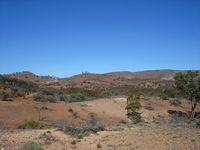
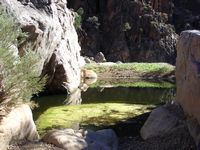
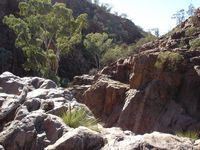
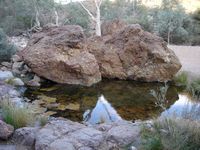
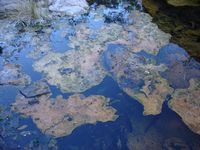
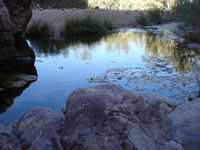
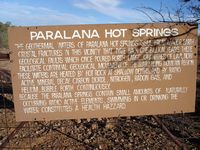
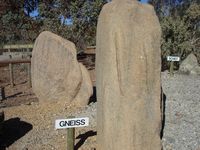
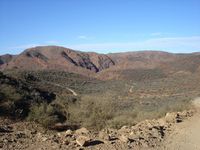
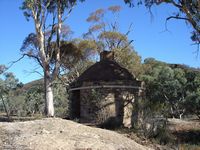
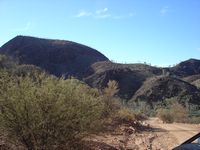
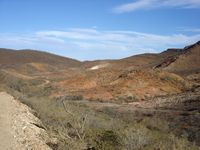
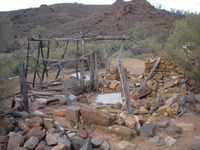
In 1946 Reg discovered the 550 million year old Ediacara fossils in the Flinders Ranges. Ediacara fossils are unique as the oldest large and complex organisms on Earth, preserved as impressions in sandstone.
As a Geologist, Reg Sprigg discovered oil and gas fields in the Cooper Basin, founded SANTOS, Geosurveys and Beach Petroleum.
Reg and Griselda and their two children then seven and ten years old were the first to cross the Simpson Desert by car in 1962 in a short wheelbase Datsun G60. In 2012 a fifty year celebratory crossing was conducted, and Reg’s two children again did the crossing, this time in a similar G60 to that original.
Reg discovered some of the deepest undersea canyons south of Kangaroo Island; about the size of the American Grand Canyon. To confirm his discoveries he took up scuba diving when it was still fairly new, and built his own boat and his own diving chamber.
Paralana is said to be one of only three springs in the world where the water is heated only by the breakdown of radioactive materials. Professor Ian Plimer explains
These are the Paralana Hot Springs in Arkaroola. They’re hot because the rocks in the hinterland
are granites with a very high amount of uranium. That Uranium is breaking down and it’s giving off heat. Any water that percolates
through the fractures in the rock gets heated up and bubbles out in a hot spring. The water comes out of the ground here at 62°c.
This is where the hot springs are bubbling out and you can see there that trails of gases are coming out. The gas is radon gas, which
is highly radioactive so this Geiger counter is picking it up.
This story begins in the spectacular Flinders Ranges in
South Australia where geologist Ian Plimer takes us to a mysterious fresh water hot spring. It belches out carbon dioxide, helium
and even radon - a highly radioactive substance with a half-life of just over two days.
This toxic soup would kill most organisms
but, amazingly, there is life in the radioactive water. A mat of green velvet slime harbours 'extremophiles' that have never been
found naturally anywhere else in the world.
Our intrepid reporter takes a sample of the radioactive slime back to the lab for
analysis. While some extremophiles are bacteria, others are so different from any other single celled organism that scientists have
created a new biological kingdom called Archaea (from archaic).
As the name suggests Archaea may be similar to the very first
organisms that populated the earth billions of years ago. In fact our little hot spring could be the perfect little laboratory to
replicate the conditions of early earth.
Using DNA sequencing, nine different species of Cyanobacteria have been identified at Paralana, with three of these being completely new to science.